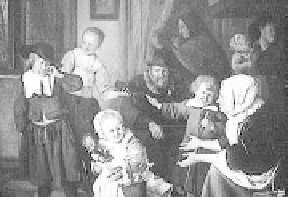Travel Reference
In-Depth Information
Rufs
I cannot tell you why Dutch men and women of the Golden
Age found these ruffled, fanlike collars attractive, but they
were the rage here and elsewhere in Europe. Ruffled col-
lars and sleeves were first popular in Spain in the 1540s, but
the style really took off with
a m a r ve l o u s d is cove r y i in
1565—starch. Within decades,
Europe's wealthy merchant
class was wearing nine-inch
collars made from 18 yards of
material.
The ruffs were detach-
able and made from a long,
pleated strip of linen set into a
neck (or wrist) band. You tied
it in front with strings. Big ones required that you wear a wire
frame underneath for support. There were various types—the
“cartwheel” was the biggest, a “double ruff” had two layers of
pleats, and a “cabbage” was somewhat asymmetrical.
Ruffs required elaborate maintenance. First, you washed
and starched the linen. While the cloth was still wet, hot metal
pokers were inserted into the folds to form the characteristic
figure-eight pattern. The ruffs were stored in special round
boxes to hold their shape.
By 1630, Holland had come to its senses, and the fad
faded.
mas present is only a branch in his shoe—like coal in your stock-
ing, the gift for bad boys. His sister gloats and passes it around.
The kids laugh at him. But wait—it turns out the family is just
playing a trick. In the background,
the grandmother beckons to him,
saying, “Look, I have your real
present in here.” Out of the lime-
light, but smack in the middle, sits
the father providing ballast to this
family scene and clearly enjoying
his children's pleasure.
Steen has frozen the moment,
sliced off a piece, and laid it on a canvas. He's told a story with a
past, present, and future. These are real people in a real scene.
Steen's fun art reminds us that museums aren't mausoleums.
Jan Steen—
The Merry Family
(1668)
This family—three generations living happily under one roof—
is eating, drinking, and singing like there's no tomorrow. The





















